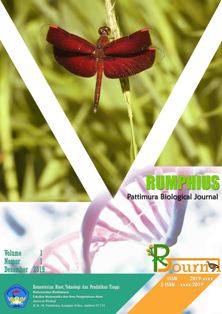INVENTORY OF MEDICINAL PLANT IN CAMPUS B UNIVERSITAS NEGERI JAKARTA
Abstract
Research on the inventory of medicinal plants at Jakarta State University Campus B was conducted from May to June 2020 at Universitas Negeri Jakarta Campus B, which is located on Jalan. Youth No.10, Rawamangun, Jakarta Timur. This study aims to determine the types of medicinal plants at Campus B. The parts of the plants used as medicine, and the types of diseases that can be treated. Research using descriptive method and literature study method. The results of the study were based on the data obtained that medicinal plants in Campus B, Jakarta State University consisted of 17 types of medicinal plants consisting of 17 families.
Downloads
References
Abdullah Muhammad, Dewi Mustikaningtyas, Talitha Widiatningrum. 2010. Inventory of Medicinal Plants in the Lowland Rain Forest of Nyamplung Village, Karimunjawa Island. Journal of Bioscientific Vol. 2 No.2. Accessed on 5 july 2021.
Adawiyah Robiatul, Mohammad Syaltut Abduh. 2019. Trials on the use of katuk leaves (sauropus adrogynus (l) merr) substitution of coconut water (cocos nucifera l.) In the production of nata de coco. Scientific Journal of Tourism, Volume 24 No. 3 . Accessed July 1, 2021.
Agusta Andria. 2015. Indonesia Has 7,500 Medicinal Plants. Bogor: LIPI
Agustin Isnaini, Vivian, Winda Lius. 2020. Use of private land as a medicine garden in the pandemi era for belian village residents. http://journal.uib.ac.id/index.php/nacospro . Accessed July 2, 2021.
Riski Nella Sari Coal. 2020. Testing the effectiveness of some concentrations of ketapang leaf extract (Terminalia catappa L.) on in vitro grayak latura. Thesis. Agrotechnology study program. State Islamic University of Sultan Syarif Kasim Riau. New Week.
Herdiani, 2012. Potential of Indonesian Medicinal Plants (online): http://www.bbpp-lembang.info/index.php/arsip/artikel/artikel-pertanian/585-potential-plants-medicine-indonesia. Accessed July 5, 2021.
Kinho, J., Arini D.I.D., Halawane, J., Conscience, L., Halidah, Kafiar Y., Karundeng M.C. 2011. Traditional Medicinal Plants in North Sulawesi Volume II. Menado: Manado Forestry Research Institute Forestry Research and Development Agency, Ministry of Forestry.
Kusuma Eka Wisnu, Disa Andriani. 2019. Characterization of red belt leaf extract (piper crocatum, ruiz&pav) as anti-diabetic drugs toward herbal medicine standardized. Kusuma Husada Health Journal. Accessed July 3, 2021.
Larassati Ajeng, Marmaini, Trimin Kartika. 2019. Inventory of medicinal plants around the yards in sentosa village. Indobiosains Journal. Vol 1.No. 2. Accessed on 30 June 2021.
Marfu'ah Nurul, Chelsea Aulia Ramadhani, Aural Miftahul Hasanah. 2019. Testing the effectiveness of bidara leaf ethanol extract (Ziziphus spina-christi L.) on the growth of Propionibacterium acne. Pharmasipha Journal, Vol.3, No.1. Accessed July 1, 2021.
Mariska Iin, Trisnu Satriadi, and Gusti Abdul Rahmat Thamrin. 2021. Ethnobotany of medicinal plant by dayak meratus community haruyan dayak village, hantakan district, hulu sungai tengah district, selatan kalimantan province. Journal of Sylva Scientaeae Vol. 04 No. 1 . Accessed July 2, 2021.
Nadeak Edi Fransiskus . 2019. Antibacterial effectiveness test of ketapang leaf extract (Terminalia Catappa) in inhibiting Escherichia coli batteries. Thesis . Medan Area University. Medan.
Nazir, Moh. (2013). Research methods. Bogor: Ghalia Indonesia.
Rohmah Siti, Euis Erlin, Jeti Rachmawati. 2021. Test of noni leaf extract (Morinda citrifolia L.) on the in-vitro growth zone of Escherichia coli bacteria. Journal of Biology Education Vol 9, No.1, pp. 34-39. Accessed July 5, 2021.
Rubiah, Djufri, Muhibbuddin. 2015. Ethnobotanical study of medicinal plants for skin diseases in the people of Pidie Regency. Journal of Educational Biology, Edition 14, Volume 7 Number 1, June 2015, p. 34 http://jurnal.unsyiah.ac.id/JBE. Accessed July 1, 2021.
Sari Ni Kadek Yunita, Ni Luh Utari Sumadewi. 2021. Antifungal Activity of Saponins of White Cambodian Flower (Plumeria acuminata) on Candida albicans ATCC 10231. Metamorphosis:Journal of Biological Sciences 8(1): 74-80. Accessed June 29, 2021.
Authors who propose a manuscript and have it approved for publication know that the manuscript will be registered and become part of the RPBJ. Authors and readers understand that this journal is open and all its contents can be accessed freely, provided that RPBJ is still listed as the source of information. The hope is that this journal can become a vehicle for exchange and scientific knowledge for society and the scientific community, especially in the field of Biology and other branches of science.









